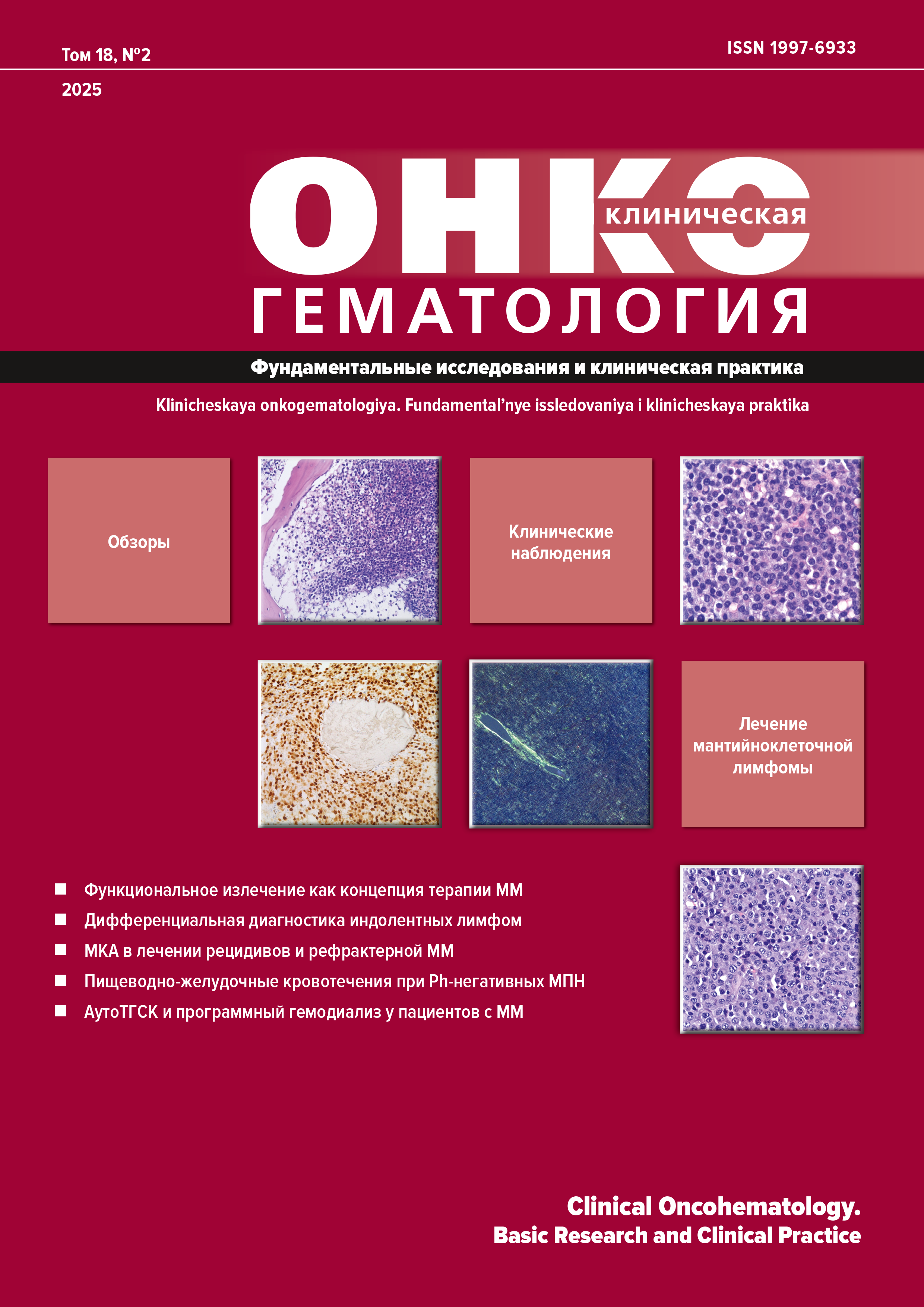Abstract
BACKGROUND. Renal failures, among them dialysis-dependent kidney disease, are common complications of multiple myeloma (ММ). Hemodialysis (HD) independence is achieved in only 20 % of standard induction therapy recipients. The survival of program HD patients remains unsatisfactory. Autologous hematopoietic stem cell transplantation (auto-HSCT) is usually planned and performed in young MM patients. However, the program HD patients are often excluded from the high-dose chemotherapy protocols with subsequent auto-HSCT due to the therapy associated toxicity risk.
AIM. To assess the efficacy and safety of auto-HSCT in MM complicated by dialysis-dependent renal failure.
MATERIALS & METHODS. In the period from 2015 to 2022, 14 program HD patients (8 men and 6 women) received auto-HSCT at the City Clinical Hospital No. 52. The median age was 53 years (range 43–66 years). In two patients, tandem transplantation was performed. Melphalan 140 mg/m2 (n = 10) was administered for pre-transplant conditioning. In 4 patients, bendamustine 200 mg/m2 was added to melphalan in the conditioning regimen. The median transfused СD34+ cell count was 3.61 × 106/kg (range 1.34–9.69 × 106/kg). By the time of completing bortezomib and/or lenalidomide induction therapy, complete remission (CR) was achieved in 5 patients, other 5 patients showed very good partial remission (VGPR), and in 4 patients partial remission (PR) was registered.
RESULTS. As reported by the control follow-up on Day +100 after auto-HSCT, all patients demonstrated further deepening of antitumor response. By this time, CR in 11 (79 %) patients and VGPR in 2 (14 %) patients were registered, whereas 1 (7 %) patient maintained PR. Renal response and HD independence were achieved in 8 (57 %) out of 14 patients enrolled in the trial. In the total group (n = 14), the 3-year event-free survival was 50 % and overall survival was 78 %.
CONCLUSION. Dialysis-dependent renal failure in MM patients is no contraindication to auto-HSCT. The latter will improve chemotherapy outcomes and make it possible to achieve renal response and HD independence.
References
- 1. Irish AB, Winearls CG, Littlewood T. Presentation and survival of patients with severe renal failure and myeloma. QJM. 1997;90(12):773–80. doi: 10.1093/qjmed/90.12.773.
- 2. Bladé J, Fernandez-Llama P, Bosch F, et al. Renal failure in multiple myeloma: Presenting features and predictors of outcome in 94 patients from a single institution. Arch Intern Med. 1998;158(17):1889–93. doi: 10.1001/archinte.158.17.1889.
- 3. Riccardi A, Gobbi PG, Ucci G, et al. Changing clinical presentation of multiple myeloma. Eur J Cancer. 1991;27(11):1401–5. doi: 10.1016/0277-5379(91)90020-e.
- 4. Analysis and management of renal failure in fourth MRC myelomatosis trial: MRC working party on leukaemia in adults. Br Med J (Clin Res Ed). 1984;288(6428):1411–6. doi: 10.1136/bmj.288.6428.1411.
- 5. Kyle RA, Gertz MA, Witzig TE, et al. Review of 1027 patients with newly diagnosed multiple myeloma. Mayo Clin Proc. 2003;78(1):21–33. doi: 10.4065/78.1.21.
- 6. Knudsen LM, Hjorth M, Hippe E. Renal failure in multiple myeloma: reversibility and impact on the prognosis. Nordic Myeloma Study Group. Eur J Haematol. 2000;65(3):175–81. doi: 10.1034/j.1600-0609.2000.90221.x.
- 7. Augustson BM, Begum G, Dunn JA, et al. Early Mortality After Diagnosis of Multiple Myeloma: Analysis of Patients Entered Onto the United Kingdom Medical Research Council Trials Between 1980 and 2002—Medical Research Council Adult Leukaemia Working Party. J Clin Oncol. 2005;23(36):9219–26. doi: 10.1200/JCO.2005.03.2086.
- 8. Evison F, Sangha J, Yadav P, et al. A population-based study of the impact of dialysis on mortality in multiple myeloma. Br J Haematol. 2018;180(4):588–91. doi: 10.1111/bjh.14394.
- 9. Barlogie B, Shaughnessy J, Tricot G, et al. Treatment of multiple myeloma. Blood. 2004;103(1):20–32. doi: 10.1182/blood-2003-04-1045.
- 10. Attal M, Harousseau JL, Stoppa AM, et al. A prospective, randomized trial of autologous bone marrow transplantation and chemotherapy in multiple myeloma. Intergroupe Francais du Myelome. N Engl J Med. 1996;335(2):91–7. doi: 10.1056/NEJM199607113350204.
- 11. Child JA, Morgan GJ, Davies FE, et al. High-dose chemotherapy with hematopoietic stem-cell rescue for multiple myeloma. Engl J Med. 2003;348(19):1875–83. doi: 10.1056/NEJMoa022340.
- 12. Knudsen LM, Nielsen B, Gimsing P, Geisler C. Autologous stem cell transplantation in multiple myeloma: outcome in patients with renal failure. Eur J Haematol. 2005;75(1):27–33. doi: 10.1111/j.1600-0609.2005.00446.x.
- 13. Lee C-K, Zangari M, Barlogie B, et al. Dialysis-dependent renal failure in patients with myeloma can be reversed by high-dose myeloablative therapy and autotransplant. Bone Marrow Transplant. 2004;33(8):823–8. doi: 10.1038/sj.bmt.1704440.
- 14. Waszczuk-Gajda A, Lewandowski Z, Drozd-Sokolowska J, et al. Autologous peripheral blood stem cell transplantation in dialysis-dependent multiple myeloma patients-DAUTOS Study of the Polish Myeloma Study Group. Eur J Haematol. 2018;101(4):475–85. doi: 10.1111/ejh.13101.
- 15. Parikh GC, Amjad AI, Saliba RM, et al. Autologous hematopoietic stem cell transplantation may reverse renal failure in patients with multiple myeloma. Biol Blood Marrow Transplant. 2009;15(7):812–6. doi: 10.1016/j.bbmt.2009.03.021.
- 16. Dimopoulos M, Sonneveld P, Leung N, et al. International Myeloma Working Group Recommendations for the Diagnosis and Management of Myeloma-Related Renal Impairment. J Clin Oncol. 2016;34(13):1544–57. doi: 10.1200/JCO.2015.65.0044.
- 17. Farag S, Jeker B, Bacher U, et al. Dose-intensified bendamustine and melphalan (BenMel) conditioning before second autologous transplantation in myeloma patients. Hematol Oncol. 2018;36(4):671–8. doi: 10.1002/hon.2546.
- 18. Mark TM, Reid W, Niesvizky R, et al. A phase 1 study of bendamustine and melphalan conditioning for autologous stem cell transplantation in multiple myeloma. Biol Blood Marrow Transplant. 2013;19(5):831–7. doi: 10.1016/j.bbmt.2013.02.013.
- 19. Gomez-Arteaga A, Mark TM, Guarneri D, et al. High-dose bendamustine and melphalan conditioning for autologous stem cell transplantation for patients with multiple myeloma. Bone Marrow Transplant. 2019;54(12):2027–38. doi: 10.1038/s41409-019-0587-0.
- 20. Durie BGM, Harousseau J-L, San-Miguel J, et al. International uniform response criteria for multiple myeloma. Leukemia. 2006;20(9):1467–73. doi: 10.1038/sj.leu.2404284.

This work is licensed under a Creative Commons Attribution-NonCommercial-ShareAlike 4.0 International License.
Copyright (c) 2025 Clinical Oncohematology

